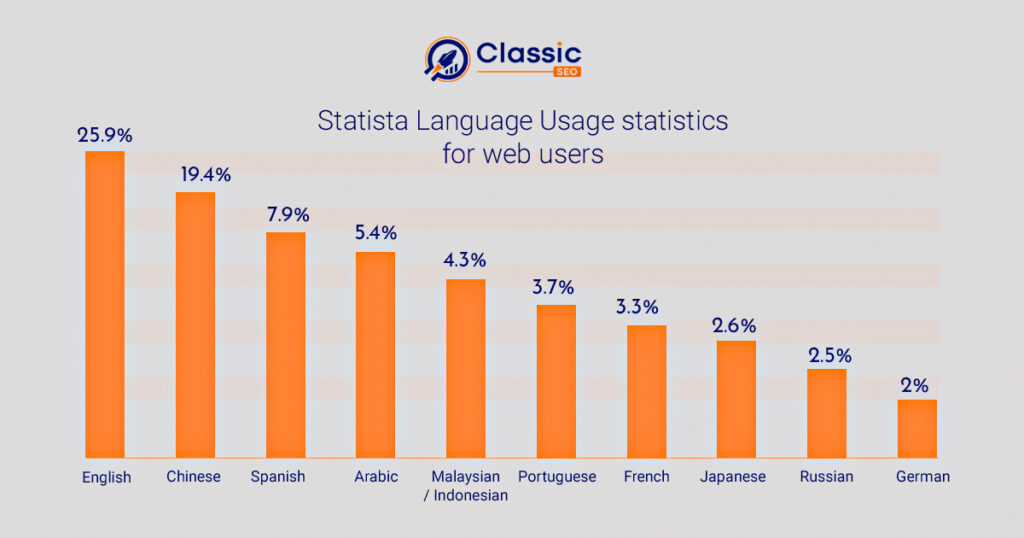Multilingual websites are the new trend of today’s time. A website that you can convert into various languages is a multilingual website. With the World becoming connected through the internet, your content may be read by a person sitting at the other end of the globe! At the same time, it’s also highly likely that he might not have the same language as you. It is when you would need a multilingual website to ensure he understands your thoughts. Nonetheless, multilingual websites are not confined to merely changing the language for the reader’s ease but also bring appropriate cultural alterations for the visitors.
What are Multilingual Websites?
Any website converted into different languages for the reader’s ease is called a multilingual website. However, you need to understand that it’s not just about merely translating content on the website. Rather, it changes subtly according to the locally accepted culture of the region where it works. Multilingual websites do not only showcase changes in their designs but also offer localized messages and offer customized content. This way, they can fetch.
What is the Difference between Multilingual and Multiregional Websites?
When SEO experts decide to upscale their craft and go ahead in the competition, they opt for multilingual and multiregional websites simultaneously. This gives them top-notch results, ensuring they can manage the audience through extensive geographical locations with great ease and expertise.
Any website owner dealing with a large and complex site should always look for an expert to manage its vastness. A multilingual or multinational website SEO set of strategies is surely complex as it has to cater to people from different languages and localities. An SEO company will help you sort out your confusion in this regard!
Simply put, when the SEO is for visitors belonging to various linguistic bases, a multiregional SEO practice is the one that tailors the website’s content according to people from multiple geographical regions. Hence, the latter strategy is much wider compared to the former. Obviously, at times, there is an overlap between these two strategies. Alongside this, they directly connect with other SEO strategies, including pay-per-click and conversion rate optimization. Together, they all make the whole SEO mechanism successful, bringing more organic traffic to the website.
What is Multilingual SEO? When do you need to implement it?
Multilingual SEO ensures that the website’s content caters to people of various languages. However, an expert SEO strategist prioritizes the website for those who read the content before optimizing it for the search engine. Hence, the visitors come before the SERPS in this strategy.
While implementing a multilingual SEO strategy, the experts tend to consider the language used in the content rather than the keywords, meta description, and headlines. The right way to get through this is to ensure the reader doesn’t spot a foreign language and closes the tab instantly. If he does so, google notices this bounce back immediately and rates it negatively.
How to Make a Strategy for Multilingual Website SEO?

Composing an entire strategy for a multilingual website SEO is necessary for success. You can’t simply wake up one day and decide to make your website multilingual. Rather, you need to curate the entire process efficiently.
Decide which Language to Target.
First, you must decide which language you need to target. Even if you are looking forward to having a strong hold on the international market, you need to realize that the volume of visitors for your content is huge. Also, most of them might not even have English as their main language.
Hence, if you don’t want to lose out on the opportunity to have them read your content, you have to choose the right language to target them. First, you need to figure out the main area from where most of your traffic is coming. Once you understand your audience well, you can find out which countries have your visitors. This way, choosing the languages for your new multilingual SEO strategy would become easier.
Decide to use a multilingual or multiregional approach or both.
If you are opting for a multiregional SEO strategy simultaneously, simply decide the region first and then opt for the specific language you want to use. It is possible to go for both these strategies together, which will surely give you a better volume of the audience coming your way.
Decide Which Content to Translate?
If you want to go extensively towards the multilingual SEO approach, you can convert all the content into a new language. However, you need to realize that to make your SEO approach successful, you have to convert the content according to the language and mindset of the target audience. Therefore, simply translating the content would offer many benefits to you.
However, if converting the entire content according to the cultural contour of the visitors having a particular language seems difficult, translating is the only way out. Hence, you must start by finding the most crucial content you want to translate.

Choose Multiple Top Level Domains.
Once the language you need to convert into it is decided and the content has been chosen, you must select the domain. You must also opt for the URL structure strategy alongside the domain selection. The URL structure targeting is much more convenient than targeting a geographic system on the page by page basis. This way, segmenting parts and geotargeting them becomes possible.
For the language conversion, you must choose either generic or location-specific domains. The gTLDs are generic top-level domains that are not specific to any country. For instance, Google automatically considers the domains ending with .biz, .edu, .net, .jobs, .org, and many others geotargeted through the Webmaster tools.
You can choose multiple top-level domains, with each one catering to a different set of audiences through its content. This way, you can enhance your visitors’ volume efficiently.
Cons of Multiple top-level domains
Though having multiple top-level domains has the advantage of keeping a wider audience for the longest time, it has its disadvantages. For instance, the cost of registering the major gTLDs would sky-rocket if your SEO strategy included transforming the content just according to the language of the reader. As it’s not a single-time purchase, you will have to renew them consistently for proper working.
Another major disadvantage of using multiple top-level domains is the enhanced chances of fraudulent activities. Various foul activities like phishing and fraud are easier with similar-sounding domain names.
Pros of Multiple Top Level Domains
Using multiple top-level domains has various advantages, which outweigh the disadvantages. The service-specific domains are more likely to inform visitors about the website. Resultantly, the website becomes purpose-driven, leading to extensive organic traffic.
Usage of multiple top-level domains makes the website much more inclusive and welcoming. It also showcases a greater diversity in terms of the audience it is trying to drive.
Consider Sub-Folders and Directories
Another element of your multilingual SEO strategy could be using sub-folders and directories. When your website caters to various languages, you can consider an option from ccTLDs, sub-folders, and manuals. Subfolders and directories let you convert your website into a truly global format. However, sub-folders may not work if you are catering to a mobile website. For that, you’ll have to stick to a highly responsive, user- and mobile-friendly design.
Think about Sub-Domains
Sub-domains are easy to use and let you manage various options efficiently. Different sub-domains are considered to be separate websites altogether. A visitor looking at varied sub-domains will think he is navigating through multiple websites rather than one. This is why they may also have different backlink profiles and SEO values. However, it may let you have microsites under one major website, which may help you upscale your multilingual SEO strategy.
Avoid URL Parameters
URL Parameters come with their associated disadvantages, which is why they should be avoided. Parameters appear in the visual form in the following manner.
site.com?loc=de
?country=france,
Its biggest issue is that it doesn’t help in segmentation according to URL, which tends to cause major confusion. Apart from this, the URL hides geotargeting. It’s especially not possible through Webmaster Tools. Hence, avoiding URL parameters is always recommended as it would hinder achieving your multilingual SEO goals.
Add Hreflang Tags
Users keen to find content in their preferred language can benefit greatly from the Hreflang Tags. However, they need to use them in the right manner. Through these tags, the visitors can see your content in the language they are most comfortable in. It is most prominently used in e-commerce websites having global operations.
Nonetheless, using the right Syntax is necessary for the Hreflang tags to be beneficial. For instance, to target the Spanish audience, you need to go for Español” using hreflang=”es”
Add Hreflang X-Default tag.
Your multilingual website must have a direct or indirect link to the localized pages for the point visitors. They can change the content easily, thanks to the X-default tag. A direct signal is sent to the algorithm that an unusual or new x-default hreflang attribute value is not suited for a particular language. You don’t need to use it necessarily. However, it helps a lot when google gets the message that a specific website doesn’t match any website.
Location Detection and Automatic Redirection. Is it a Good Approach?
Location detection is one of the best approaches to make a part of the SEO strategy while making your website. This is a panache of automation when the website automatically detects the visitor’s location and redirects him to change the language. It saves a lot of time and hassle for him. Though it’s an extensive procedure for the SEO expert, it makes life easier for the visitors.
Instead of Redirection. Let User Decide to Switch Language
Nonetheless, if you don/t want to redirect the visitor so that you don/t appear too authoritative, it’s always better to let the user decide to switch language. This strategy works great for visitors who themselves are multi-lingual. This way, they would be able to change the original language of the content into the kind of language he is most comfortable in.
Avoid Machine and Automated Translation
Machine and automated translation is a huge turn-off for the reader. Anything that is generated by the machine would be too emotionless! The reader won’t be able to get the essence of the content if the machine automatically translates it.
Get a Native Speaker to Translate.
Who would be a better person to translate the content than a native speaker? He would be well aware of the ins and outs of the language quite well. Alongside this, he would be able to make the content appealing and effective. Wherever needed, he would add the locality’s necessary proverbs and famous sayings. Hence, choosing a native speaker to do the translation task for your website is a great idea.
Do Comprehensive Keyword research in Other Languages?
If you want an audience from different linguistic backgrounds, you should also be able to do extensive keyword research in other languages. This will expand your horizons and let you see beyond a limited space efficiently.
Get Backlinks for Multilingual pages.
Backlinks for multilingual pages are necessary for the website to perform well. You can do so through various actions like guest posting, composing link-worthy content, collaborating with other creators, being a part of listicles, and many more!
Final Thoughts
In today’s time and age, it is necessary to make sure that people from vast geographical areas consume the content on your website. The competition is high, and you need to set your bar! Opting for the multilingual strategy will surely work great for your website and would bring huge volumes of organic traffic towards it!

